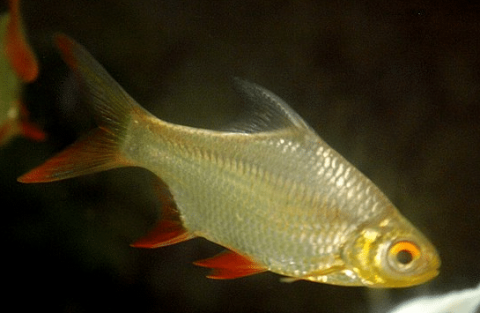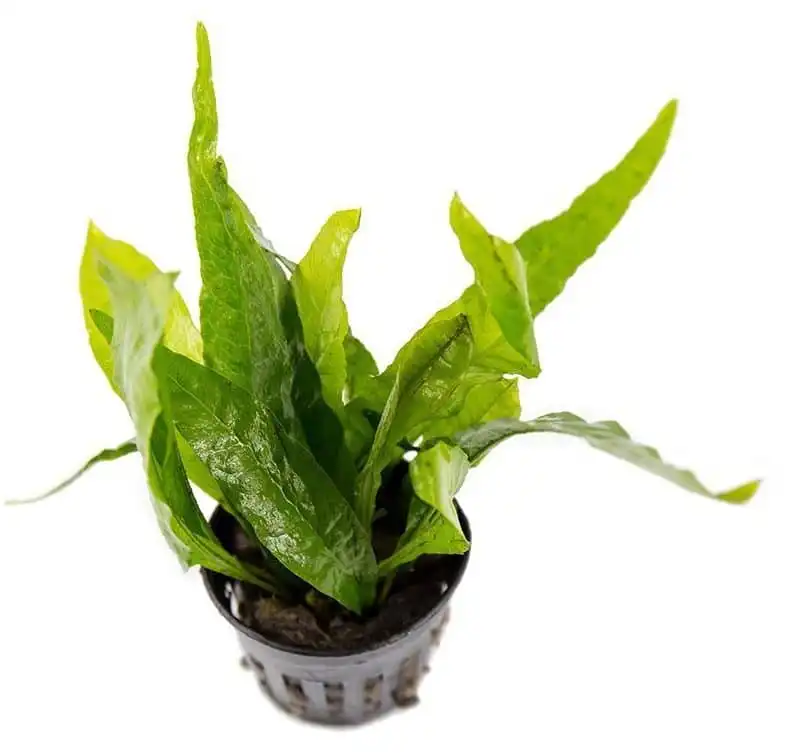Thank you for visiting! By the way… any links on this page that lead to products on Amazon and other stores/partners are affiliate links Aquarium Store Depot earns a commission if you make a purchase.
Tinfoil barb is a great choice for you if you fancy large aquariums with large fish that swim like a charm.
The graceful and ever-so-spectacular fish such as Tinfoil barb prefer large aquaria and share their bond with other tropical fish similar in size and temperament.
In this article, I will share everything about tinfoil barbs and how you can keep them happy and thriving for a good 10 years, or maybe, longer!
Stay with me.
Key Takeaways
- Tinfoil barbs are smart and intelligent pets that can easily recognize their owners. You can even hand-feed them and teach them exciting things like swimming through the hoops.
- Tinfoil barbs have great instincts. They can hear vibrations in the water and even detect pressure changes and other movements.
- In some countries, tinfoil barbs are considered a delicacy and bred on fish farms.
- In terms of swimming and tank activities, tinfoil barbs are considered superactive freshwater fish that are capable of swimming up to 37 miles per hour.
- Most tinfoil barbs are artificially colored and sold under many names including pink, orange, and blue tinfoil barbs, etc.
Overview
| Scientific Name | Barbonymus schwanenfeldii |
| Common Names | Goldfoil Barb, Schwanefeld’s Barb, River Barb |
| Family | Cyprinid |
| Origin | Tropical regions in Borneo, Sumatra, Thailand, and the Malayan peninsula |
| Diet | Omnivore |
| Care Level | Moderate |
| Activity | High |
| Lifespan | 8 to 10 years |
| Temperament | Semi aggressive fish |
| Tank Level | All levels |
| Minimum Tank Size | 75 gallon minimum (125+ – 200+ recommended for a school) |
| Temperature Range | 72.0 to 77.0° F (22.2 to 25.0° C) |
| Water Hardness | 2 – 10 dGH |
| pH Range | 6.5 – 7.5 |
| Filtration/Water Flow | Strong |
| Water Type | Freshwater |
| Breeding | Egg Scatterers |
| Difficulty to Breed | Difficult |
| Compatibility | Compatible with like-minded and like-sized fish species |
| OK, for Planted Tanks? | With Caution |
Brief Introduction
The tinfoil barb (Barbonymus Schwanenfeldii), or Goldfoil barb, Schwanefeld’s Barb, River Barb is one of the largest fish from the Cyprinid family. The tinfoil barb species are aquatic gentle giants that need a spacious aquarium with lots of beautiful tank decorations. So, if you have the required huge space, this barb fish is ideal for you because it is:
- Beautiful and impressive
- Easy to care for
- Peaceful species
Also, they are schooling fish that lives the best with a school of five fish or more of their size and kind. If you’re keeping them in a tinfoil barb aquarium, be sure to clean the tank regularly and keep an eye on the fish’s activities.
Origin & Habitat
The tinfoil barbs come from the native streams of Borneo, Sumatra, Thailand, and the Malayan peninsula. Later, it was introduced in Singapore and other places. Therefore, they are widely available worldwide.
In the wild, they can be found in rapidly moving rivers and streams. Similarly, in your aquarium, Tinfoil Barbs will appreciate strong currents and strong moving water.
Appearance
In their natural state, the tinfoil barbs are silver or golden yellow in color with lustrous scales. Their fins have beautiful hues of black, orange, and red.

The bodies of tinfoil barbs are torpedo-shaped and have high back and forked tail fin. The dorsal fin is usually red with black blotch along its tip. They also have red pectoral, pelvic, and anal fins. While the caudal fins are orange or have a shade of deep with black submarginal stripe on the upper and lower ends.
Difference between Juvenile and Adult Tinfoil Barb fish
The juvenile tinfoil barbs are different from the adult in terms of body and fin coloration. The young tinfoil barbs have basic silver or tin-plated scales. As they grow older, they develop color to their scales and the pelvic and anal fins turn red with a white tip on the dorsal fin.
Appearance-wise, tinfoil barb resembles their smaller cousins, red-tail tinfoil barb. But, tinfoil barbs are much larger. Other than their size, they are almost identical.
What is the average adult size?
The average adult size of a tinfoil barb is almost 14 inches or 35 cm in length. Therefore, the aquarium size should be no less than 225 gallons.
How long do they live?
Tinfoil barbs are here to stay with you for a good 8 to 10 years. Even longer, when taken good care of their water parameters and other requirements.
Artificially Colored Tinfoil barb:
You may find some bizarre, intriguing colors in the tinfoil barb that are rather transparent or albino. These artificially colored freshwater fish are sold under many different names such as Blushing Tinfoil Barb or colored names like blue, pink, purple, and orange.
Even though attractive, the artificially colored variety poses serious challenges to the fish-keeping world. Therefore, many experts raised serious concerns about this practice because this process may cause stress and pain to the fish. Eventually, the tinfoil barb may be exposed to infections and other diseases by this process.
Food & Diet
Wild tinfoil barbs feed mainly on plant material, but since they are omnivores; they also eat treats in the form of worms, insects, submerged land plants, crustaceans, small fish, and filamentous algae.
In captivity, tinfoil barbs eat all kinds of live food, fresh, frozen, or flake food, such as brine shrimp, and bloodworms. In short, they love proteins and also, tinfoil barb eat small fish. So, it’s not recommended to keep small or tiny fish in their aquarium as they might see them as potential prey.
Additionally, their diet should also contain vegetable substitutes such as wafers, cooked lettuce, spinach, or oatmeal. You can also feed them algae wafers.
How often to feed them?
If you’re feeding them once a day, only feed them enough food for a 5-minute meal. If you’re feeding them several times a day, give them no more than they can consume in three minutes or less.
Temperament and Behavior
Generally, tinfoil barbs are peaceful fish species. However, make sure you don’t keep them with tiny fish because they might end up harming other small fish. All in all, they are peaceful schooling species that are enthralling to watch in home aquariums.
I advise keeping them in a school of at least 5 or more fish of the same size and temperament. Also, avoid keeping shyer fish that prefer slow moving water as they are super active and prefer fast moving water. As a result, the other slow fish might feel intimidated by them and may feel unnecessarily stressed.
Tinfoil Barb Tank Mates
The ideal tank mates for tinfoil barbs are:
- Bala shark
- Angelfish
- Silver dollar
- Tetras
- Plecos
- Arowanas
- Gouramis (Gold, Opaline, and blue)
- Large cichlids like the Oscar Cichlid
- Fire eel
- Clown loach
Complete Care Guide
Tinfoil barb is a moderately hardy freshwater fish that is very easy to care for. Therefore, it is ideal for beginner aquarists. However, because they are very large freshwater fish, their demands are particular. As a result, things might not work out for beginner aquarists.
If you’re adamant on keeping tinfoil barbs as an adorable pet, proper tank setup with ideal water requirements should be maintained.
Tank Requirements
Since tinfoil barbs grows very large rapidly, you need a spacious tank of no less than 225 gals (852 L). Also, they thrive in a community aquarium to feel comfortable. Additionally, you need high-quality filters to keep the water in optimal conditions and maintain high levels of oxygen and water flow in the tank.
The tinfoil barb fish species are skilled jumpers, so a tank lid or cover is highly recommended to keep them safe. In the natural tinfoil barb habitat, the water is fast flowing with active currents, so you need to mimic the environment by powerheads. They also love to burrow the substrate and soil, so you need to place some of the hardest aquarium plants that can survive their wrath.
Tank Size
The minimum tank size for a Tinfoil barb tank is no less than 225 gallons or 852 litres. Since they grow very large, they are not suitable for nano tanks or small tanks.
Water Parameters
Here is the ideal water for a tinfoil barb tank:
| Water temperature range: | 72.0 to 77.0° F (22.2 to 25.0° C) |
| pH range: | 6.5-7.5 (slightly acidic) |
| Water hardness Range: | 2 – 10 dGH |
| Water movement: | Strong |
Live Plants
Unfortunately, when it comes to keeping live plants, tinfoil barbs are complete monsters. They will destroy the plants even if they are well-fed and happy. Due to this, many aquarists give up the idea of a planted tank with Tinfoil fish.
However, if you’re determined, you should keep hard-leaved plants Anubias with thick, waxy leaves that the tinfoil barbs find hard to eat. Other great live plants are Crinum, Larger Vals, Java Fern, and Sagittaria.
Java Fern is one of the easiest and hardiest live plants you can purchase
Tank Decorations
The tinfoil barb doesn’t leave live plants and tank decorations in good condition if they are too immaculate for their tank.
Therefore, it is recommended to keep large pieces of driftwood as tank decorations on a sandy substrate to mimic their natural habitat.
Substrate
Though the tinfoil barb will do pretty much great in an empty tank, a sandy substrate with scattered rocks or pebbles is an ideal option for their tank.
Filtration and Aeration
Since tinfoil barb needs a very large tank to stay healthy, the need for maintaining water quality is optimal for a healthy environment.
I recommend installing canister filters to keep the water clean and free of nitrates and nitrites. Also, canister filters will help you maintain high levels of oxygenation and water flow, ideal for tinfoil barbs.
High flow, large filtration capacity, and quality plumbing - The FX series is designed for monster fish keepers
Additionally, tinfoil barbs are active swimmers and need a sufficient supply of oxygen. Therefore, the tank water should be well-oxygenated. I recommend getting an air stone or bubbler to help increase the surface area of water and provide more oxygen to the tank.
Though canister filters also provide aeration while agitating the water surface. It’s still advisable to get air stones for adequate aeration.
Aquarium Care
Tinfoil barbs are moderately easy to care for, especially when you keep their water clean. I recommend doing 25% to 50% water changes weekly or biweekly. Also, algae magnets should be placed to keep your tank free of algae.
Overall, if you have a community tank with tank decorations and live plants, perform water changes weekly. Otherwise, monthly water changes are essential to keep the water clean.
Breeding
Tinfoil barb breeding is fairly difficult in captivity. Not because breeding is a challenging process, but because of their exceptionally large size.
Like all other fish from the Cyprinid family, Tinfoil barb lays eggs and scatters them in the tank. The female tinfoil barb lays around thousand eggs. However, they pose a serious threat to their eggs and might end up eating some. Therefore, it’s advisable to separate the breeding pair once the eggs are laid and fertilized.
Though, there are no known cases of breeding tinfoil barbs in captivity. However, it would be a rewarding experience for aquarium hobbyists1.
First of all, start with a separate breeding tank with a bare-bottom tank with spawning mops or live plants, so you can easily find their eggs. After you’ve set up the tank with the required water conditions, it’s time to put the breeding pair in it. It’s advisable to put one male for every 2-3 females.
Tinfoil barb breed during the rainy season, so you can stimulate their breeding behavior by increasing the water flow in the breeding tank and lowering the water level. Also, low water temperatures are recommended.
When the conditions meet their breeding requirements, the male tinfoil barb will follow the female and nudge their bellies to release the eggs. The eggs will later be fertilized by the male tinfoil barb. Since tinfoil barbs are known to eat their eggs, it’s better to separate them after fertilization and spawning.
The eggs hatch in around 48 hours. And once they are hatched, the fry will feed on their egg sacs for 1 to 2 days. After a few days, you can feed them commercially available fry food or infusoria. Baby brine shrimp and mosquito larvae can also be given after a week.
It’s important to maintain water quality to avoid diseases and other problems in the tank.
Fish Diseases
Tinfoil barbs are hardy fish that may ditch many fish diseases. However, like every other fish, they can be prone to certain conditions due to poor water quality and parameters.
Therefore, to avoid fish diseases, it’s important to maintain the water quality to promote a healthy ecosystem.
Some of the common diseases your tinfoil barb may get due to lack of care are:
- Ich
- Fin rot
- Dropsy
- Velvet
- Columnaris
All of the above diseases are either caused by parasites or bacteria or fungi that are usually found in unclean and unhygienic tank conditions.
FAQs
Are albino tinfoil barbs aggressive?
Albino tinfoil barb is semi-aggressive fish and may become territorial if they feel threatened or stressed. Therefore, it’s important to provide these fish with ample free swimming space in a large tank.
Is tinfoil barb edible?
Though they are sold for only aquariums and are not suitable for consumption, tinfoil barb are still eaten as a popular food item. It is widely used in soups, stews, and curries.
Is tinfoil barb aggressive?
Tinfoil barbs are generally peaceful fish species. However, they may get aggressive with small fishes or other species smaller than them.
How fast do tinfoil barbs grow?
When taken good care of, the growth rate of tinfoil barb is very high. Young tinfoil barbs grow up to 2 inches per month during their first year of life.
What is the maximum size of a tinfoil barb in an aquarium?
The maximum size of an adult tinfoil barb is around 14 inches in length. However, the final size depends on the diet, water conditions, and tank size.
Final Thoughts
Tinfoil barbs are beautiful, impressive creatures that are ideal for your spacious tanks. The tinfoil barb prefers large tank mates that are active swimmers and thrive in fast-moving waters. In the aquarium hobby, these fish species are known for their peaceful, schooling nature and difficulty in breeding.
Therefore, if your only goal is to breed them; think again before buying tinfoil barbs. Otherwise, if you’re looking for some quirky addition to your home aquariums, tinfoil barbs are your best bet!
- About the Author
- Latest Posts
I’m thrilled that you found Aquarium Store Depot! Here you’ll find information on fish, aquariums, and all things aquatics related. I’m a hobbyist (being doing this since I was 11) and here to help other hobbyists thrive with their aquariums! I adhere to a high quality Editorial Process and Review products with real life field usage and practical analysis.







